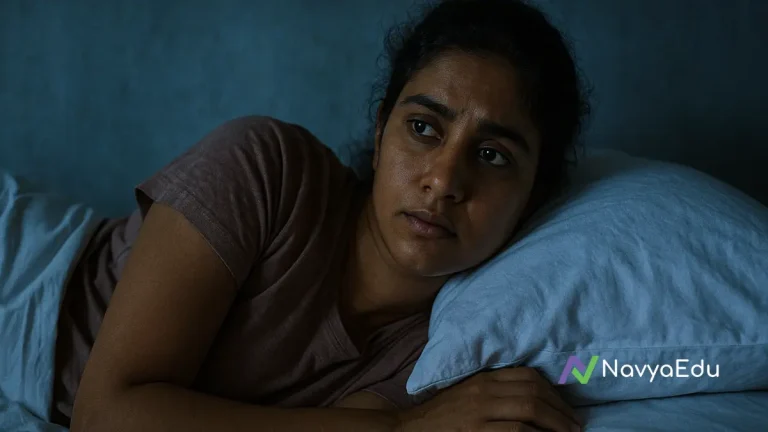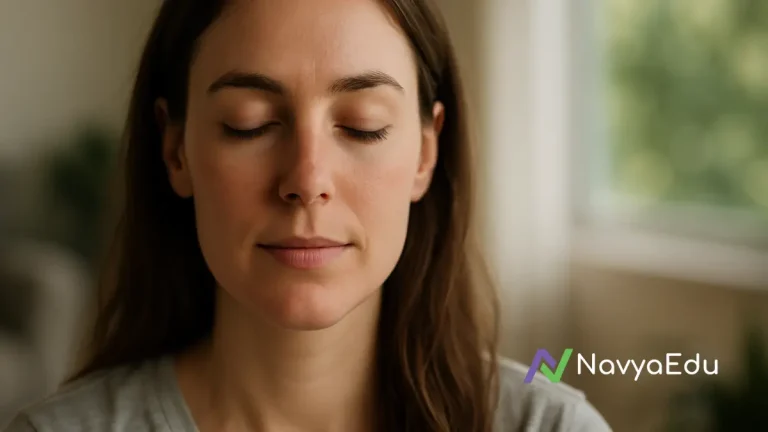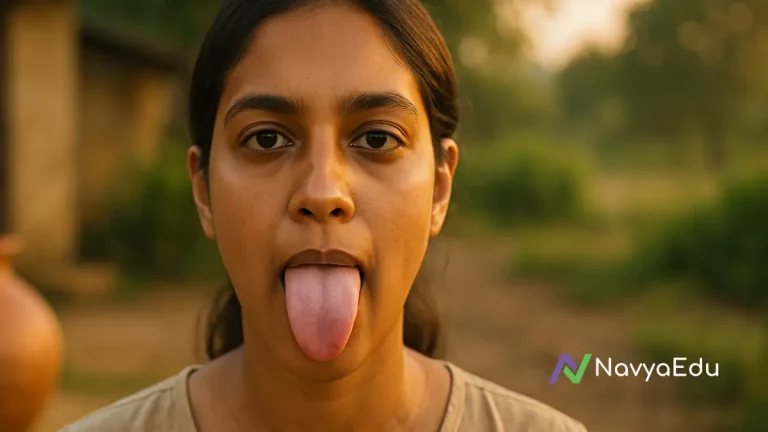When My Mind Wouldn’t Shut Up…
There was a time when even the quietest night felt deafening inside my head.
I’d lie awake staring at the ceiling, thoughts spiraling—replaying conversations, worrying about tomorrow, doubting decisions I’d already made. I tried deep breathing, journaling, guided meditations… nothing stuck. Then, during a short trip to my grandmother’s village in Rajasthan, I noticed something that changed everything.
She’d sit silently every evening, holding a tiny copper bowl filled with water, dipping her fingers in, and rhythmically tapping the center of her forehead.
She called it “man-shaant kriya”—a traditional mind-calming technique passed down generations. And surprisingly, it took just two minutes.
The first time I tried it, I wasn’t expecting much. But something shifted. My thoughts slowed down. My breath deepened. It felt like my brain finally exhaled.
This isn’t just village wisdom. Science is beginning to catch up. And today, I want to share this powerful 2-minute technique that anyone can use—anytime your mind won’t stop racing.
🌪️ What Is Overthinking? And Why It’s So Dangerous
Overthinking is more than just “thinking too much.” It’s a form of mental looping—your brain fixates on worries, decisions, past regrets, or hypothetical situations. You’re stuck in your head, analyzing but never resolving.
💡 Did You Know?
Studies from the University of Michigan reveal that chronic overthinking can increase your risk of insomnia, anxiety disorders, high blood pressure, and even depression.
In Ayurveda, this constant mental chatter is linked to an imbalance in Vata dosha—the energy of air and space. When Vata is aggravated, the mind becomes restless, anxious, and ungrounded.
Silencing the mind isn’t just about peace. It’s about protecting your brain, your body, and your long-term health.
✅ Benefits of This 2-Minute Mind-Silencing Practice
This simple Vedic-inspired practice—called the Third Eye Cooling Tap—activates a powerful feedback loop between the skin, breath, and brain. Here’s how it helps:
1. Instant Mental Calmness
Tapping the center of your forehead (your “third eye” region) gently activates the parasympathetic nervous system, which helps lower cortisol and calm racing thoughts.
🧘♀️ “It’s like switching your brain from chaos to calm in seconds,” says Dr. Radhika Iyer, Ayurvedic psychologist.
2. Helps Balance Vata Dosha
According to Ayurveda, the third eye is the seat of intuition. Applying cool water and tapping here grounds the nervous energy, stabilizing mood swings and mental overstimulation.
3. Triggers Acupressure Points
In traditional Chinese medicine, the point between the eyebrows—Yintang—is known for relieving anxiety, tension, and insomnia. This practice works similarly.
4. Improves Sleep Onset
Doing this technique before bed signals your brain to slow down. Many people report falling asleep faster or waking up less during the night.
5. Increases Mindfulness & Focus
Stopping to tap your forehead disrupts unconscious overthinking loops. You come back to your body—and the present moment.
6. No Tools, No Tech, No Side Effects
Unlike apps or supplements, this ancient practice costs nothing, has no risk, and can be done anywhere—from your car to your cubicle.
🔬 Scientific Backing: Why It Works
While traditional Ayurveda teaches energy-balancing through marma points (vital energy centers), modern science offers parallel insights:
- Neuroscience: Gentle tapping or acupressure activates the prefrontal cortex, calming the amygdala (the brain’s fear center).
- Therapeutic Touch: Studies in Complementary Therapies in Medicine show that light forehead tapping can regulate heart rate and reduce mental agitation.
- Water Therapy: According to hydrotherapy principles, applying cool water to the forehead stimulates the vagus nerve, known for reducing anxiety and lowering stress hormones.
💡 According to the International Journal of Yoga, daily stimulation of the third eye region improves emotional regulation and reduces rumination.
🛠️ How to Practice the 2-Minute Third Eye Cooling Tap (Step-by-Step)
🌿 You’ll need: A small bowl of cool (not icy) water, preferably stored in a copper or clay vessel.
✅ Step-by-Step Guide:
- Find a quiet space – Sit or lie down comfortably. Close your eyes.
- Dip your index and middle fingers in the cool water.
- Gently tap the center of your forehead (between your eyebrows) in a slow, steady rhythm for 1–2 minutes.
- Focus on your breath as you tap: Inhale slowly… exhale fully.
- Optional: Whisper a calming mantra like “Shaantih…” or just say “Calm” silently with each tap.
🕯️ Tip: Use clay or copper bowls to enhance the grounding energy—these materials are traditionally believed to calm excessive Vata.
⚠ Side Effects & Safety Tips
This method is gentle and generally safe for all. However:
- Don’t tap too hard—your forehead is sensitive.
- Avoid extremely cold water (can trigger headaches in sensitive people).
- People with migraines should start with brief sessions and observe effects.
- Children can do this under adult guidance for anxiety or sleep issues.
🧑⚕️ Always consult your healthcare provider before integrating any new wellness practice, especially if you have a diagnosed neurological or psychiatric condition.
🙋 My 7-Day Experience: “I Never Thought Silence Could Feel This Safe”
I did this practice every night for 7 days—after dinner, before bed.
Day 1 felt like a weird ritual. By Day 3, I noticed I wasn’t checking my phone obsessively. My thoughts slowed. I felt less snappy during the day.
By Day 7, I didn’t just sleep better. I woke up feeling lighter—as if I had more space inside my mind.
It wasn’t magic. But it was healing.
🔄 Alternatives & Comparisons
| Technique | Benefits | Drawbacks |
|---|---|---|
| Third Eye Cooling Tap | Fast, no tools, grounding | May feel odd at first |
| Deep Breathing | Scientifically backed | Requires focus and time |
| Journaling | Emotional clarity | Can stir up more thoughts |
| Guided Meditations | Structured, effective | Needs a device, internet |
This tapping method stands out because it’s embodied—you use your fingers, your breath, your awareness. It pulls you out of your mind into your body, which is exactly where healing begins.
❓ People Also Ask (FAQs)
1. Can this technique stop overthinking instantly?
Yes, for many people it brings rapid mental stillness. While it may not erase all thoughts, it slows mental noise enough to regain control.
2. Can children or teenagers use it for anxiety or exams?
Absolutely. It’s a gentle, non-invasive technique. Just ensure they use lukewarm water and tap softly.
3. Is this the same as tapping therapy or EFT?
Similar in approach but simpler. EFT includes affirmations and tapping multiple points. This focuses only on the third eye and breath.
4. How often should I do it?
Once daily is enough—especially before sleep or during stressful moments.
5. Can I combine this with meditation or prayers?
Yes, it enhances mindfulness and can deepen your spiritual practice.
6. What if I don’t feel any change?
Give it a week. Some people need repetition to break mental patterns. Be consistent and gentle.
7. Why copper or clay bowls?
In Ayurveda, copper balances the mind-body system and enhances energy grounding. Clay absorbs excess Vata. Metal bowls are also fine.
8. Does it cure anxiety or insomnia?
It is a support technique—not a cure. Always seek professional help for persistent issues.
🌟 Final Thoughts: Sometimes, the Simplest Rituals Heal the Deepest Wounds
We live in a world of constant noise—notifications, deadlines, doubts. But ancient wisdom whispers a reminder:
Stillness is already inside you.
If you’ve been drowning in your own thoughts, give this 2-minute technique a try. No gadgets. No mantras. Just water, touch, and breath.
You don’t need to escape your mind. Just return to your body.
🧘♀️ “If your mind feels like a battlefield, perhaps all it needs… is a little forehead peace.”




